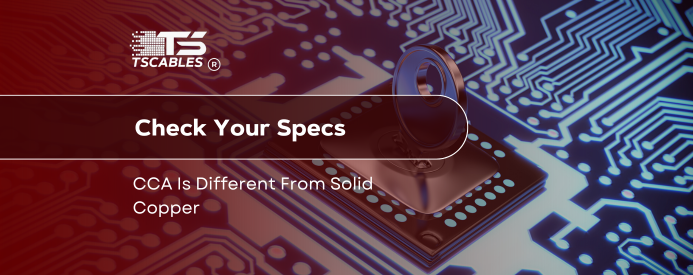Ever bought a cable that seemed like a bargain, only to find your devices lagging or connections dropping? You might have encountered Copper-Clad Aluminum (CCA) cables. While they look like genuine copper cables, their performance tells a different story.
Understanding the differences between CCA and solid copper is crucial for anyone setting up a reliable network. Let's dive into why CCA cable isn't the same as solid copper and what that means for your connectivity.
What Is CCA Cable?
CCA wire combines an aluminum core with a thin copper coating. Manufacturers often promote it as a cost-effective alternative to pure copper cables.
However, this composition leads to higher resistance, making CCA Ethernet cables less efficient in transmitting signals. The aluminum core also makes them more brittle, increasing the risk of breakage during installation or over time.
Why Solid Copper Matters
Solid copper cables, on the other hand, consist entirely of pure copper. This composition ensures lower resistance, better conductivity, and overall superior performance. When comparing CCA wire vs copper, solid copper stands out for its durability and reliability, especially in demanding network environments.
Performance Differences: CCA vs. Copper
When evaluating Ethernet cables, the choice between CCA cable and solid copper can significantly impact network performance. While both may appear similar externally, their internal compositions lead to distinct differences in conductivity, durability, and compliance with industry standards. Understanding these differences is crucial for ensuring reliable and efficient network installations.
Conductivity
Copper's superior conductivity ensures faster and more reliable data transmission. CCA cables come with their aluminum cores, and they can't match this efficiency.
Durability
Solid copper cables are more robust and less prone to damage. In contrast, CCA Ethernet cable is more susceptible to wear and tear. As a result, it can lead to potential network issues.
Compliance
Many industry standards require pure copper conductors. Using CCA vs copper Ethernet cables might lead to non-compliance. This is especially the case in professional settings.
Safety Concerns with CCA Cables
Using copper-clad aluminum wire vs. copper isn't just about performance, it's also about safety. CCA cables can overheat, especially when used for Power over Ethernet (PoE) applications. This overheating can pose fire risks, making them unsuitable for many installations.
Moreover, copper vs CCA discussions often highlight that CCA cables don't meet many safety standards, further emphasizing the risks involved. Furthermore, CCA cables are more prone to physical damage due to their brittleness, increasing the likelihood of breaks or faults during installation and use.
The aluminum also oxidizes over time, leading to poor connectivity and potential arcing. It further elevates fire risks. Importantly, CCA cables often fail to meet established safety standards such as UL 444 and TIA-568-C, and their use is prohibited in many commercial installations under the National Electrical Code (NEC).
Utilizing these non-compliant cables can result in failed inspections, legal liabilities, and increased insurance premiums. In summary, while CCA cables may offer initial cost savings, the associated safety hazards and potential for non-compliance make them a risky choice for any network infrastructure.
Identifying CCA Cables: Important Things to Consider
Recognizing CCA cables is essential to ensure network reliability and safety. While they may resemble solid copper cables externally, several methods can help differentiate them:
Weight Comparison
CCA cables are notably lighter than solid copper cables due to aluminum's lower density. If a cable feels unusually light, it might be CCA.
Visual Inspection
Examine the cut end of the cable. CCA wire typically reveals a silver-colored aluminum core beneath the copper cladding. On the other hand, solid copper cables display a uniform reddish hue throughout.
Scratch Test
Gently scrape the conductor with a sharp tool. If the underlying metal is silver, it's likely aluminum, indicating a CCA cable.
Manufacturer's Markings
Check the cable's sheath for any inscriptions. Some manufacturers label their products with "CCA" to indicate copper-clad aluminum composition.
Resistance Testing
Using a multimeter, measure the cable's resistance. CCA cables exhibit higher resistance compared to solid copper cables of the same gauge and length.
Conclusion
Choosing the right cable is vital for network performance and safety. While CCA cables might seem like a cost-effective solution, their drawbacks often outweigh the initial savings. For reliable, efficient, and safe networking, solid copper cables are the clear choice.
Looking for high-quality solid copper cables? Trust TS Cables to provide top-notch products that ensure your network runs smoothly and safely.
FAQs
What is the main difference between CCA and solid copper cables?
CCA cables have an aluminum core with a copper coating, while solid copper cables are made entirely of pure copper, and that is why they offer better conductivity and durability.
Are CCA cables safe for Power over Ethernet (PoE) applications?
No, CCA cables can overheat during PoE applications. Therefore, they pose safety risks and potential damage to connected devices.
How can I identify if a cable is CCA or solid copper?
Check the weight, flexibility, and color of the stripped wire. CCA cables are lighter, more brittle, and reveal an aluminum core when stripped.
Do CCA cables meet industry standards?
Many industry standards require pure copper conductors. CCA cables often don't meet these standards, leading to potential compliance issues.
Why are CCA cables cheaper than solid copper cables?
Aluminum is less expensive than copper. As a result, it makes CCA cables more affordable. However, this cost-saving comes at the expense of performance and safety.






